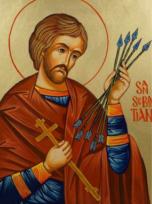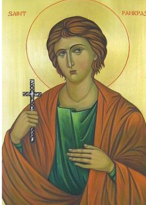Saint SebastianFeast Day: 20 January |
Saint PancrasFeast Day: 12 May |
| Sebastian was born at Narbonne, Gaul. He became a soldier in the Roman army at Rome in about 283, and encouraged Marcellian and Marcus, under sentence of death, to remain firm in their faith. Sebastian made numerous converts: among them were the master of the rolls, Nicostratus, who was in charge of prisoners and his wife, Zoe, a deaf mute whom he cured; the jailer Claudius; Chromatius, Prefect of Rome, whom he cured of gout; and Chromatius’ son, Tiburtius. Chromatius set the prisoners free, freed his slaves, and resigned as prefect.
Sebastian was named captain in the praetorian guards by Emperor Diocletian, as did Emperor Maximian when Diocletian went to the East. Neither knew that Sebastian was a Christian. When it was discovered during Maximian’s persecution of the Christians that Sebastian was indeed a Christian, he was ordered executed. He was shot with arrows and left for dead, but when the widow of St. Castulus went to recover his body, she found he was still alive and nursed him back to health. Soon after, Sebastian intercepted the Emperor, denounced him for his cruelty to Christians, and was beaten to death on the Emperor’s orders. Sebastian is patron of archers, athletes, and soldiers, and is appealed to for protection against plagues. |
Saint Pancras was a Roman citizen who converted to Christianity, and was beheaded for his faith at the age of just 14 around the year 304. His name is Greek and literally means “the one that holds everything”.
During the persecution of Christians by Diocletian, around 303 AD, Pancras was brought before the authorities and asked to perform a sacrifice to the Roman gods. Diocletian, impressed with the boy’s determination to resist, promised him wealth and power, but Pancras refused, and finally the emperor ordered him to be decapitated on the Via Aurelia, on May 12, 303 AD. A Roman matron named Ottavilla recovered Pancras’s body, covered it with balsam, wrapped it in precious linens, and buried it in a newly built sepulchre dug in the Catacombs of Rome. Pancras’ head was placed in the reliquary that still exists today in the Basilica of San Pancrazio. Some of his relics found their way to England, which is why many of the nation’s churches are dedicated to him; St Pancras Old Church in London is believed to be one of the oldest sites of Christian worship in England. Pancras is invoked against cramps, false witness, headache, and perjury. Pancras is also patron saint of children. |

